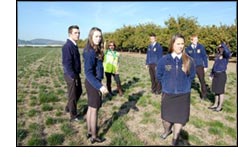
FFA team tours Riverbend, stewardship site News Register - October 18, 2013 - Molly Walker It's still in the dream stage, but the state FFA youth leadership harbors hope Yamhill County will land a proposed Oregon FFA Leadership and Agriculture Center. The idea originated with Carlton winemaker and civic leader Ken Wright. He is serving on a committee charged with identifying compatible agriculturally oriented uses for so-called "stewardship lands" being made available for community use by Waste Management Inc., operator of McMinnville's Riverbend Landfill. He thought a statewide FFA center would be ideal, and his suggestion was quickly embraced by the FFA, which was in the early stages of identifying an agriculturally oriented site for new state facilities. Altogether, Waste Management is making 450 acres of landfill buffer zone available for uses compatible with rural farm life. It has formed a broad-based Stewardship Committee to identify options. A new base for statewide FFA operations is just one of several developed by the committee, but it has probably fired the most imagination and rallied the most support. Jackie Lang, regional communications director for Waste Management, took the FFA's top officers on a tour Thursday of both the landfill and the adjacent site. The officers are 2013 high school grads from around the state. They have put their college plans on hold for a year to represent the youth agriculture organization. The roster includes President Luke Wildhaber, a Dayton High grad, and Treasurer Aaron Moreland, a Newberg High grad. It also includes Vice President Sarah Rutledge of Sandy, Secretary Jessica Roland of Ontario, Reporter Remington Frazier of Imbler and Sentinel Jake White of Burns. The youth leaders were accompanied by Kevin White, executive director for the Oregon FFA Foundation. Wildhaber brought personal experience to the visit, as he spent his high school years working on a farm lying just north of the landfill. "This is where my grassroots come from," he said. After touring the landfill, the group toured the stewardship lands. It started a 60-acre parcel, where the committee hopes to establish small farm plots that businesses, individuals and non-profits can use to raise produce for on-site sale, working with a marketing manager. Lang said the spread includes a farmhouse that could serve as a business office. She said a commercial kitchen could be installed there, enabling users to add a prepared food component as well. "This is kind of a complex idea," she said. "But there's a lot to love about it." After traversing that site, the officers walked an area behind the Schmidt Farm, one of the two potential sites identified for the statewide FFA facility. It features flat acreage under active cultivation. And much of that acreage could remain under active cultivation, as the FFA would love to have a working farm serve as a centerpiece. Lang said the Stewardship Committee put a high priority on maintaining mainstream agriculture and tapping its economic value. And she said the FFA would do that. "I'm looking forward to the potential if the FFA gets the land," she said. Frazier said it would provide a place where the organization could host more activities, including agricultural training activities. "Everything starts with a strong foundation," he said. Roland said Oregon already has a national reputation in FFA ranks, and development of a statewide ag center would serve to enhance that. Jake White said it would be good to have a permanent home for the organization, which is currently making do with temporary facilities at Oregon State University. Kevin White said the foundation has created a Facilitation Committee to work with Waste Management and its Stewardship Committee in pursuit of the idea. If it begins to gel, the parties would need to draw up a number of legal agreements, he said. Count Wildhaber as someone who is psyched about the prospect. "I feel the FFA is going to be an integral part of this land," he said. "The generosity of Waste Management is immense." The proximity of the landfill did nothing to dampen his enthusiasm. When he was growing up, Wildhaber said, he dreaded going to the dump, largely thanks to the odor. But he said it's a very different kind of operation today. After taking a tour, he said, "I have a greater appreciation for the engineering, science and technology that goes into a landfill. My eyes have been opened." Moreland said he could also see potential in an alliance with Waste Management, which aims to retain ownership of the buffer lands. "Having connections with Waste Management allows for an environmental aspect," Moreland said. "It really opens up the doors for students to explore other subjects, in addition to agricultural concepts." The leadership group subsequently toured a second potential site, near a 25-acre parcel where Waste Management aims to develop a high-tech processing plant designed to significantly reduce the waste stream. Lang said the Yamhill River could be spanned by a footbridge there, affording recreational access to the other side. Lang said a buffer would have to be developed to deal with sound and sight issues. She said that's something the company could design and the organization could carry out as a hands-on project. Wildhaber said the project "would be very much a dream come true." He said the group has developed a 20-20 vision program, through which it dreams big for FFA's future. Now, he said, "A lot of it is happening. We feel like a kid in a candy shop with not enough quarters." Print This Page |